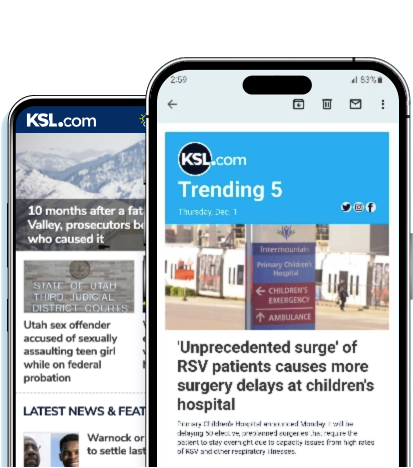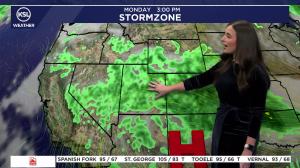Estimated read time: 6-7 minutes
This archived news story is available only for your personal, non-commercial use. Information in the story may be outdated or superseded by additional information. Reading or replaying the story in its archived form does not constitute a republication of the story.
SALT LAKE CITY, — Since the “Me Too” movement began, sexual harassment cases, often involving celebrities, politicians and CEOs of major companies, have filled the headlines. Hundreds of powerful people have been the subject of sexual misconduct allegations.
They are allegations that are often kept private, but when they happen in the public sector and involve taxpayer dollars, they don’t have to be.
The KSL Investigators wanted to discover the public cost of sexual harassment in Utah, and discover misconduct that’s often left in the dark. They spent six months examining every government agency in the state: every town, every city, every county, every school district and every state agency.
They looked at 432 government entities and dug through thousands of pages of sexual harassment cases, lawsuits and settlements over the past 10 years.
One of those settlements grabbed headlines in 2015.
Sexual harassment in the Salt Lake City Police Department
“When I look back at my career at the police department it was good. It was really good,” Robin Heiden said.
Heiden spent twenty years on the force with the Salt Lake City Police Department. She was an investigator with internal affairs, the first woman on the SWAT team and the public face of the department for many years. Now, she reports on safety segments for KSL. Her list of credentials is long and impressive.
It’s a career full of proud moments and no regrets — except one.
“I should have reported it early on and I never did,” Heiden said. “And then it just got worse and worse until somebody finally reported it on my behalf.”
Heiden sat down with KSL Investigators and opened up about a case she has never spoken about publicly. She was one of three female police officers who made headlines saying they were sexually harassed by a superior officer, Rick Findlay, beginning in 2011.
“A picture was one of the big things that was spread around the department,” Heiden said. “I had heard from a couple of people that they had been shown a picture of me in my bikini and my best friend that we did not give to him.”
Heiden said that’s where the harassment started, and it continued for years.
Finally, someone reported it anonymously. An internal affairs review substantiated inappropriate behavior, but Heiden said no action was taken against the accused officer.
“To this day I want to tell myself, it must have been some sort of miscommunication because I can’t imagine nothing would have been done,” Heiden said.
Under pressure from then Salt Lake City Mayor Ralph Becker, the case ultimately led to the resignation of Police Chief Chris Burbank over how the situation was handled.
Settlements by the numbers
It’s a complaint that’s heard far too often: sexual harassment claims that go unheard and unpunished.
These claims sometimes lead to lawsuits, which can then lead to settlements. When it happens in the public sector, it’s not just the victim paying the price — it’s also the taxpayer.
While settlements do not admit any fault, here’s a few examples of what public records show:
- In 2014, a Myton woman claimed she was stalked and kidnapped by the chief of police. The chief was fired and the city paid her $50,000 to settle the claim.
- In 2016, a city employee in northern Utah said she was sexually harassed by the city’s mayor. The mayor kept his job, but the city paid her $195,885 after she filed a lawsuit.
- Also in 2016, a school counselor in Iron County was accused of sexually harassing at least eight female coworkers over a seven-year period. The women filed a lawsuit and the school district paid them $540,000 combined to settle the claim.
Out of the 320 cases KSL Investigators examined, they discovered a few more things.
The agency that fights lawsuits most often is the Utah Transit Authority. UTA only had one settlement but took at least three other cases to court. The total cost in attorney fees was $351,997.
Provo City had the biggest one-time settlement. The city paid out $750,000 to five women who said they were harassed by the city’s former police chief.
When it comes to sheer numbers, Salt Lake City had the most sexual harassment or discrimination lawsuits filed against them in a 10-year period — 10 women in all and a total of seven payouts.
“I think the government is much more willing to try to settle the case early,” said employment law attorney Russell Monahan.
Monahan has experience fighting government agencies over harassment and discrimination. He believes the public sector settles more quickly than the private sector, but not because they’re more willing to spend taxpayer money.
“I don’t think it’s a matter of taxpayer dollars,” Monahan said. “I think it’s a matter of, we see exposure here, let’s try to settle this before it explodes.”
Sherie Peek said she was sexually harassed by a supervisor while employed at the Salt Lake County Jail.
“He made the comment that it would be worth putting you up in the acute medical unit just to see you naked,” Peek said. “I just couldn’t believe it.”
Now, she’s suing Salt Lake County, saying that not only was nothing done but also that she was retaliated against for coming forward.
“The last thing I wanted to do was be in a federal lawsuit with the county. But it was wrong. Everything about it, it was wrong,” Peek said.
Peek is still battling her case in the courtroom, but other cases never make it that far. While some government agencies choose to fight, others choose to settle.
When KSL Investigators added up the total cost of settlements and attorney fees, they found that sexual harassment among government agencies in Utah over the past decade comes with a price tag of more than $4.5 million.
In some cases KSL found, the government agency’s insurance company paid the settlements, but not in every case.
Cultural change
Heiden said it’s important to know she was sexually harassed by a single individual and that it was not a department-wide problem. Nonetheless, it was a problem she had to speak up about.
“I think I feel stronger,” Heiden said. “I know that I would never put up with that again. I know that for a fact.”
In 2015, Heiden and her two fellow officers filed a lawsuit against Salt Lake City. The city settled, paying each of them $85,000. But the changes that came about within the police department because of the lawsuit were more important to Heiden.
“A big part of the lawsuit was that we wanted change and we asked them for change,” Heiden said. “We wanted policies changed, we wanted more training, we wanted people to know exactly what was wrong with sexual harassment and what is sexual harassment.”
While it’s easy to focus on the dollar signs, change is the real goal of many of these lawsuits: change in policy, change in behavior and a change in culture that has too long tolerated sexual harassment.
“What do you hope will come out of this lawsuit?” Headrick asked Peek.
“I hope change. Nobody, no woman should have to go through this,” Peek said. “It doesn’t matter who they are or where they come from or what position they’re working in. And I’m hoping that it makes a difference that more women will stand up and not be afraid.”









